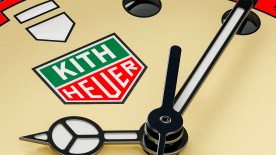Press release
The Soyouz spacecraft landed on Tuesday, May 24th 2011, on the steppes of Kazakhstan, with the Swisschronograph, El Primero Striking 10th aboard, having spent 159 days in space.

Moscow, May 25th 2011. The international space station (ISS), is a huge space mammoth, which weighs 400 tons and moves at an incredible speed of 27,700 km/h. The ISS goes completely around our planet in approximately an hour and a half. Accompanying a scientific mission led by the European Space Agency (ESA), the El Primero Striking 10th Swiss chronograph has just spent 159 days in this superstructure. On Tuesday, May 24th, the Russian flight control centre announced that the spacecraft had made a “gentle landing”. Three aeroplanes and 14 helicopters were on standby to ensure a safe landing and to help the three team members disembark as quickly as possible. Amongst them, the European astronaut was wearing the ZENITH timepiece. Both are doing fine.
Outer space: the great new human adventure
Since its beginnings, ZENITH has demonstrated a marked pioneering spirit, accompanying explorers, guiding sailors on their expeditions (ZENITH marine chronometers helped to calculate the position of ships at sea), helping pilots or the discoverers of the poles. It was therefore completely natural for the brand to partner with this great new human adventure: the conquest of outer space.
The El Primero Striking 10th high-precision chronograph
The Striking 10th high-precision chronograph that is thus returning from space is equipped with the El Primero in-house calibre, the first automatic movement to beat at a high frequency, meaning 10 vibrations per second. Invented by ZENITH in 1969 – the year of man's first steps on the moon – this movement represents the most sophisticated series-made mechanical “engines” and the one displaying the highest level of precision. The Striking 10th model created in 2010 represents a significant horological breakthrough: for the first time in a ZENITH watch, it showcases this 1/10th of a second by providing a view of each pulse of this exceptional movement.

ZENITH watches have participated in some of mankind's greatest adventures : the discovery of the North and South poles by explorer Roald Amundsen ; Mahatma Ghandi's peaceful struggle for Indian independence; the early steps in the field of ecology under the guidance of the scholarly Prince Albert 1st of Monaco; Louis Blériot's Channel crossing; John F. Kennedy's political activities; the solo flight of the North Pole in a hot-air balloon by French doctor Jean-Louis Etienne; and soon, very soon, a watch will attempt to be the first to break the sound barrier in direct contact with the stratosphere, thereby proving its exceptional reliability.
The International Space Station
Length : 108m
Width : 74m
Height : 45m
Pressurised volume : 1,200m³
Total final weight : 400 tons
Beginning of construction : November 20th 1998
Orbit altitude : 370 – 460vkm
Travelling speed : 7.7km/s, 27,700km/h
Solar panel surface : 2,500m2, supplying 110kW electricity
Cost : 100 billion dollars
Partners : American Space Agency (NASA), European Space Agency (ESA), Russian Space Agency (Roscosmos), Canadian Space Agency (CSA) and the Japanese Space Agency (JAXA)

European Space Agency (ESA)
The European Space Agency represents an access point to outer space for Europe. The Agency's projects are designed for us on Earth to learn more about our immediate space environment, the solar system and the universe, as well as developing satellite technology and services and to promote European industries. The ESA consists of 18 member states: Germany, Austria, Belgium, Denmark, Spain, Finland, France, Greece, Ireland, Italy, Luxemburg, Norway, the Netherlands, Portugal, the United Kingdom, Sweden, the Czech Republic, and Switzerland. In addition, Canada, Hungary, Poland and Rumania also cooperate on certain projects with the ESA.
How many people work for the ESA ?
In 2010, the ESA's permanent staff consisted of 1900 employees. These highly qualified people come from all member states and include scientists, engineers, specialists in information technologies, as well as admin staff.






